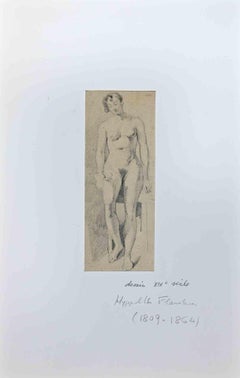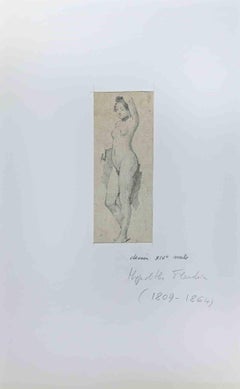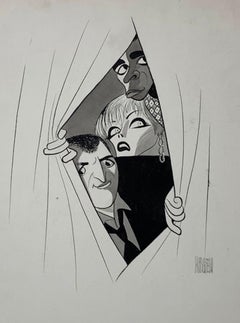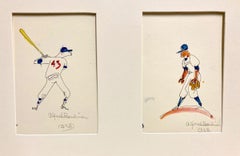Jean-Hyppolyte Flandrin Art
to
3
Overall Width
to
Overall Height
to
2
1
3
2
1
3
3
2
2
1
1
2
1
3
9,475
2,687
1,375
1,358
Artist: Jean-Hyppolyte Flandrin
Nude of Woman- Original Drawing by Jean-Hyppolyte Flandrin - Mid-19th century
By Jean-Hyppolyte Flandrin
Located in Roma, IT
Nude of Woman is an Original Pencil Drawing realized by Jean-Hyppolyte Flandrin.
The little artwork is in good condition on a yellowed paper.
Signature by pencil on the back of the drawing, included a white cardboard passpartout (33.2x21 cm).
Jean-Hippolyte Flandrin (23 March 1809 – 21 March 1864) was a 19th-century French painter. His celebrated 1836 work Jeune Homme Nu...
Category
Mid-19th Century Modern Jean-Hyppolyte Flandrin Art
Materials
Pencil
Nude of Woman- Original Drawing by Jean-Hyppolyte Flandrin - Mid-19th century
By Jean-Hyppolyte Flandrin
Located in Roma, IT
Nude of Woman is an Original Pencil Drawing realized by Jean-Hyppolyte Flandrin.
The little artwork is in good condition on a yellowed paper.
Signature by pencil on the back of the drawing, included a white cardboard passpartout (34x21.5 cm).
Jean-Hippolyte Flandrin (23 March 1809 – 21 March 1864) was a 19th-century French painter. His celebrated 1836 work Jeune Homme Nu...
Category
Mid-19th Century Modern Jean-Hyppolyte Flandrin Art
Materials
Ink
Two Figures - Original Drawing by Jean-Hyppolyte Flandrin - 19th Century
By Jean-Hyppolyte Flandrin
Located in Roma, IT
Two Figures is an Original China Ink Drawing realized by Jean-Hyppolyte Flandrin.
The little artwork has a missing corner.
Signature by pencil, included a white cardboard passpartout (35x51 cm).
Jean-Hippolyte Flandrin (23 March 1809 – 21 March 1864) was a 19th-century French painter. His celebrated 1836 work Jeune Homme Nu...
Category
Mid-20th Century Modern Jean-Hyppolyte Flandrin Art
Materials
Ink
Related Items
Mission Impossible Original TV Guide Drawing Illustration Caricature Mid Century
By Albert Al Hirschfeld
Located in New York, NY
"Mission Impossible" Original TV Guide Drawing Illustration Caricature Mid Century NYC with Greg Morris, Barbara Bain, and Steve Hill. This original drawing...
Category
1960s American Modern Jean-Hyppolyte Flandrin Art
Materials
Ink, Board
Alfred Bendiner, (Baseball Hitter and Pitcher -- The Philadelphia Phillies?)
By Alfred Bendiner
Located in New York, NY
Of course it's possible that these baseball players aren't from a Philadelphia team, but I doubt it. There was so much drama and intrigue with both the Philadelphia Phillies...
Category
Mid-20th Century American Modern Jean-Hyppolyte Flandrin Art
Materials
India Ink, Watercolor
"Steel Factory" Cuban Mid 20th Century Modern Drawing WPA Latin Art Industrial
Located in New York, NY
"Steel Factory" Cuban Mid 20th Century Modern Drawing WPA Latin Art Industrial
Ink on paper. 12 x 19 inches. Pogolotti lived in Paris in the 1930s. The drawing here comes from the collection of his Parisian ophthalmologist, Dr. Prokopenko . Unfortunately, the artist lost his eyesight in 1938.
Marcelo Pogolotti (1902–1988) was a Cuban painter...
Category
1930s Modern Jean-Hyppolyte Flandrin Art
Materials
Paper, Ink
"Manhattan Bridge" NYC American Scene Modernism Watercolor WPA Urban Realism
By Reginald Marsh
Located in New York, NY
Reginald Marsh "Manhattan Bridge" NYC American Scene Modernism Watercolor WPA Urban Realism, 20 x 14 inches. Watercolor and pencil on paper, 1938. Signed...
Category
1930s American Modern Jean-Hyppolyte Flandrin Art
Materials
Paper, Watercolor, Pencil
$55,000
H 26 in W 20 in D 2 in
beggars spanish modernism colored pencils
By Ricard Opisso Sala
Located in Sitges, Barcelona
Ricard Opisso - Beggars - Colored pencils
Measurements drawing 21x31cm.
Frame measures 39x48 cm.
Damaged paper at bottom.
Anti-reflective glass.
Son of Alfredo Opisso y Viñas, journalist, historian and critic, and of Antonia Sala y Gil, his sister Regina Opisso, was also a writer. He comes from an enlightened family full of artists. His paternal grandfather was Josep Opisso y Roig, journalist and director of the Diari de Tarragona, father of the also writers Antonia Opisso y Viña and Antoni Opisso y Viña. His maternal great-grandfather was the painter Pere Pau Montaña, his maternal grandfather the fabulist Felipe Jacinto Sala and his maternal uncle, the painter Emilio Sala y Francés. His nephew was Arturo Llorens y Opisso, a writer better known under his pseudonym Arturo Llopis.
Although he was born in Tarragona, his family moved to Barcelona when Opisso was only two years old. In modernist Barcelona at the end of the 19th century, Opisso worked as an assistant to Antonio Gaudí in the works of the Sagrada Familia in Barcelona since 1892. He was linked to the group Els Quatre Gats, along with Ramón Casas...
Category
1940s Modern Jean-Hyppolyte Flandrin Art
Materials
Color Pencil
$2,242 Sale Price
47% Off
H 8.27 in W 12.21 in
Male Torso
By John Koch
Located in London, GB
Pencil, coloured pencil and chalk on paper, titled (lower left), signed (lower right), 31cm x 46cm, (51cm x 68cm framed).
John Koch was an American painter and teacher, and an impo...
Category
1950s American Modern Jean-Hyppolyte Flandrin Art
Materials
Paper, Chalk, Pencil, Color Pencil
"Marc Chagall" Original Drawing Illustration Caricature William Saroyan book
By Albert Al Hirschfeld
Located in New York, NY
"Marc Chagall" Original Drawing Illustration Caricature William Saroyan book
This drawing was published in the 1976 edition of William Saroyan's SONS ...
Category
1970s American Modern Jean-Hyppolyte Flandrin Art
Materials
Ink, Board
$14,000
H 21.625 in W 14.75 in
Indian Dancer - Vintage Illustration in Ink and Watercolor
By Irene Pattinson
Located in Soquel, CA
Indian Dancer - Vintage Illustration in Ink and Watercolor
A stoic, dark-haired woman in elaborate dress is sitting cross-legged in this illustration by Irene Pattinson (American, 1909-1999). Pattinson uses fine ink line detail and a vibrant pink watercolor for a splash of color.
Signed at the bottom, "Irene Pattinson."
Provenance: The Artist, Estate of Irene Pattinson: David Carlson; Estate of Larry Miller Fine Art, Robert Azensky Fine Art.
Presented in a new white mat with foam core backing.
Mat size: 16"H x 12"W
Paper size: 11.75"H x 8.5"W
Image size: 7.5"H x 6.5"W
Irene Pattinson (American, 1909-1999) studied at the California School of Fine Art (now The San Francisco Art Institute), San Francisco State College and The Marion Hartwell School of Design. She was President of the San Francisco Woman Artists Association 1955-56.
Provenance: The Artist, Estate of Irene Pattinson: David Carlson; Estate of Larry Miller Fine Art, Robert Azensky Fine Art.
Solo Exhibitions: Lucien Labaudt Gallery 1955; San Francisco Museum of Art, 1961 (39 works).
Selected Group Exhibitions: San Francisco Art Association Annual 1948, 54, 55; San Francisco Woman Artists, 1957-1960; Oakland Art Museum Annual, 1951, 58; California Palace of the Legion of Honor, 1960; Richmond Art Center, 1955, 56, 57, 58; San Francisco Art Institute 1959, 60. The Art Bank of the San Francisco Art Association, 1958, 59, 60, 62, 63; Winter Invitational, California Palace of The Legion of Honor, San Francisco, 1960; Fourth Winter Invitational, California Palace of The Legion of Honor, San Francisco, 1963.
Awards: First Place, San Francisco Woman Artists Assoc., 1957, 1959; San Francisco Art Festival 1957;Literature: San Francisco Art Institute - A catalog of the Art Ban 1962/63; San Francisco and the Second Wave: The Blair Collection
Exhibitions:
1963 The Art Bank of the San Francisco Art Association, San Francisco, CA
1963 California Palace of The Legion of Honor: Forth Winter Invitational, San Francisco, CA
1962 The Art Bank of the San Francisco Art Association, San Francisco, CA
1961 San Francisco Museum of Art, San Francisco, CA
1960 California...
Category
1950s American Modern Jean-Hyppolyte Flandrin Art
Materials
Paper, India Ink, Watercolor, Pen
$1,150
H 16 in W 12 in D 0.25 in
African Mama - Vintage Illustration in Ink and Watercolor
By Irene Pattinson
Located in Soquel, CA
African Mama - Vintage Illustration in Ink and Watercolor
A charming illustration, by Irene Pattinson (American, 1909-1999), shows a woman with a...
Category
1950s American Modern Jean-Hyppolyte Flandrin Art
Materials
Paper, India Ink, Watercolor, Pen
$636 Sale Price
20% Off
H 13 in W 10 in D 0.25 in
Sidney Poitier & Tony Curtis Oscar Winning 1958 film The Defiant Ones Caricature
By Albert Al Hirschfeld
Located in New York, NY
"The Defiant Ones" Tony Curtis Sidney Poitier Oscar Winning 1958 film Caricature. Two escaped convicts chained together, one white and one black, must l...
Category
1950s Modern Jean-Hyppolyte Flandrin Art
Materials
Ink, Board
$55,000
H 29 in W 36 in D 2 in
Respite
Located in London, GB
Pencil on paper
Signed and dated (lower right)
29cm × 21cm (48cm × 39cm framed)
A truly original artist, Lear spent most of his 70 year career exploring beautifully proportioned mal...
Category
1980s American Modern Jean-Hyppolyte Flandrin Art
Materials
Paper, Pencil
1940s Charcoal and Pencil Portrait of a Man
Located in Arp, TX
Artist Unknown
"Tie and Glasses"
c. 1940s
Charcoal and pencil on paper
13.5"x17" site 19"x23" rustic wood frame
Unsigned
Category
1940s Modern Jean-Hyppolyte Flandrin Art
Materials
Paper, Charcoal, Carbon Pencil
Jean-hyppolyte Flandrin art for sale on 1stDibs.
Find a wide variety of authentic Jean-Hyppolyte Flandrin art available for sale on 1stDibs. You can also browse by medium to find art by Jean-Hyppolyte Flandrin in ink, pencil and more. Much of the original work by this artist or collective was created during the 19th century and is mostly associated with the modern style. Not every interior allows for large Jean-Hyppolyte Flandrin art, so small editions measuring 3 inches across are available. Jean-Hyppolyte Flandrin art prices can differ depending upon medium, time period and other attributes. On 1stDibs, the price for these items starts at $357 and tops out at $418, while the average work can sell for $357.




